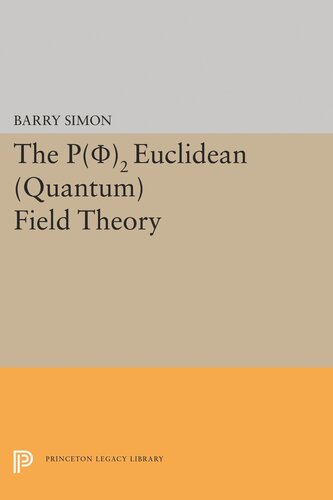

Most ebook files are in PDF format, so you can easily read them using various software such as Foxit Reader or directly on the Google Chrome browser.
Some ebook files are released by publishers in other formats such as .awz, .mobi, .epub, .fb2, etc. You may need to install specific software to read these formats on mobile/PC, such as Calibre.
Please read the tutorial at this link: https://ebookbell.com/faq
We offer FREE conversion to the popular formats you request; however, this may take some time. Therefore, right after payment, please email us, and we will try to provide the service as quickly as possible.
For some exceptional file formats or broken links (if any), please refrain from opening any disputes. Instead, email us first, and we will try to assist within a maximum of 6 hours.
EbookBell Team

4.7
66 reviewsBarry Simon's book both summarizes and introduces the remarkable progress in constructive quantum field theory that can be attributed directly to the exploitation of Euclidean methods. During the past two years deep relations on both the physical level and on the level of the mathematical structure have been either uncovered or made rigorous. Connections between quantum fields and the statistical mechanics of ferromagnets have been established, for example, that now allow one to prove numerous inequalities in quantum field theory.
In the first part of the book, the author presents the Euclidean methods on an axiomatic level and on the constructive level where the traditional results of the P(Ø)2 theory are translated into the new language. In the second part Professor Simon gives one of the approaches for constructing models of non-trivial, two-dimensional Wightman fields—specifically, the method of correlation inequalities. He discusses other approaches briefly.
Drawn primarily from the author's lectures at the Eidenössiehe Technische Hochschule, Zurich, in 1973, the volume will appeal to physicists and mathematicians alike; it is especially suitable for those with limited familiarity with the literature of this very active field.
Originally published in 1974.
The Princeton Legacy Library uses the latest print-on-demand technology to again make available previously out-of-print books from the distinguished backlist of Princeton University Press. These editions preserve the original texts of these important books while presenting them in durable paperback and hardcover editions. The goal of the Princeton Legacy Library is to vastly increase access to the rich scholarly heritage found in the thousands of books published by Princeton University Press since its founding in 1905.